AMD's Richland vs. Intel's Haswell GPU on the Desktop: Radeon HD 8670D vs. Intel HD 4600
by Anand Lal Shimpi on June 6, 2013 12:00 PM ESTCompute
As always we'll start with our DirectCompute game example, Civilization V, which uses DirectCompute to decompress textures on the fly. Civ V includes a sub-benchmark that exclusively tests the speed of their texture decompression algorithm by repeatedly decompressing the textures required for one of the game’s leader scenes. While DirectCompute is used in many games, this is one of the only games with a benchmark that can isolate the use of DirectCompute and its resulting performance.
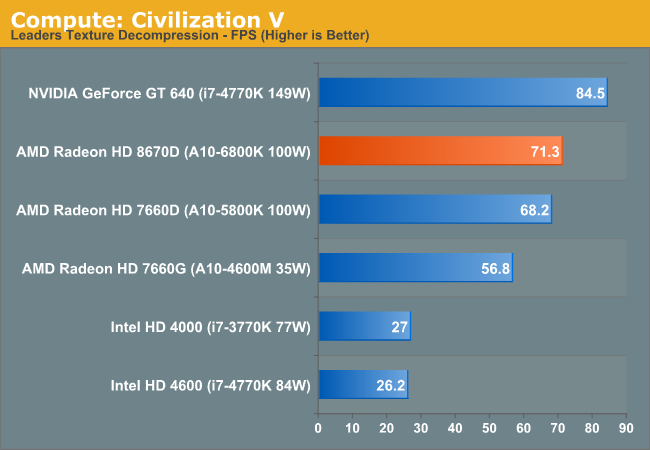
AMD does extremely well in our sole DirectCompute test, outperforming Intel's latest desktop graphics solution by a huge margin.
Our next benchmark is LuxMark2.0, the official benchmark of SmallLuxGPU 2.0. SmallLuxGPU is an OpenCL accelerated ray tracer that is part of the larger LuxRender suite. Ray tracing has become a stronghold for GPUs in recent years as ray tracing maps well to GPU pipelines, allowing artists to render scenes much more quickly than with CPUs alone.
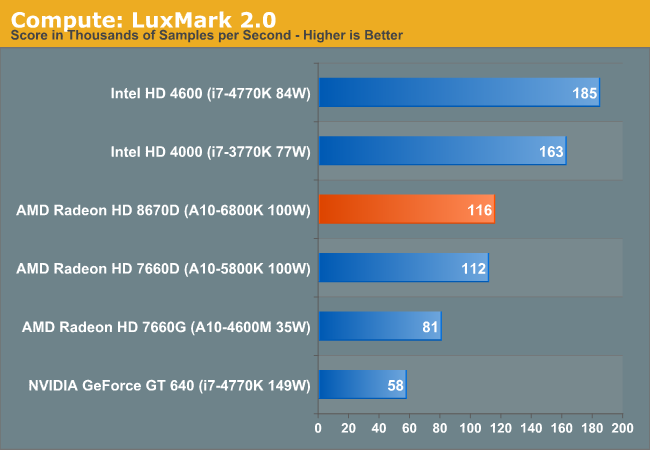
Haswell GT2's OpenCL performance can be very good, which is what we're seeing here. HD 4600 ends up being almost 60% faster than the Radeon HD 8670D.
Our 3rd benchmark set comes from CLBenchmark 1.1. CLBenchmark contains a number of subtests; we’re focusing on the most practical of them, the computer vision test and the fluid simulation test. The former being a useful proxy for computer imaging tasks where systems are required to parse images and identify features (e.g. humans), while fluid simulations are common in professional graphics work and games alike.
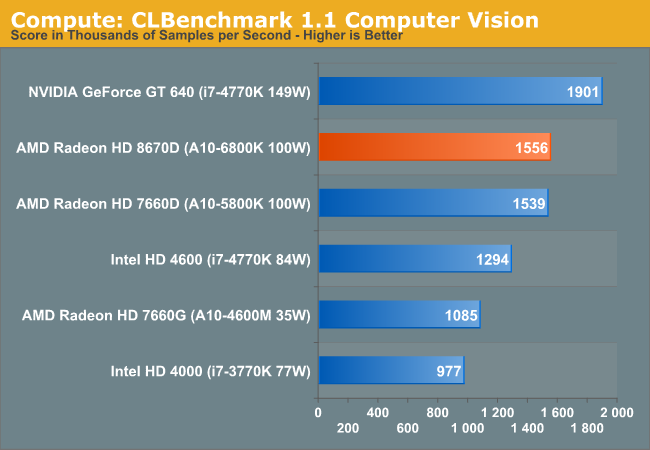
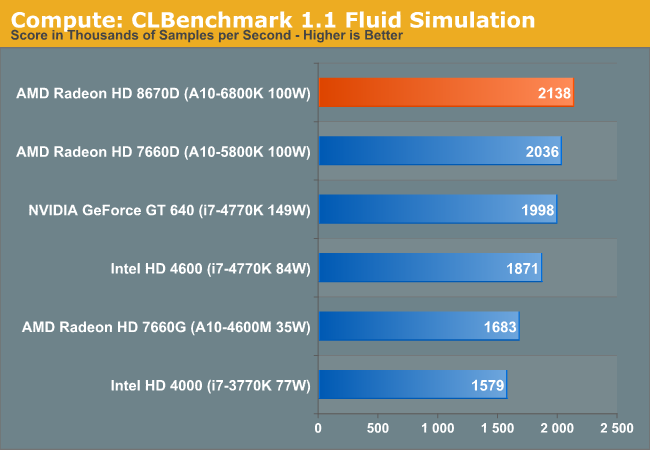
AMD and Intel trade places once again with CLBenchmark. Here, Richland does extremely well.
Our final compute benchmark is Sony Vegas Pro 12, an OpenGL and OpenCL video editing and authoring package. Vegas can use GPUs in a few different ways, the primary uses being to accelerate the video effects and compositing process itself, and in the video encoding step. With video encoding being increasingly offloaded to dedicated DSPs these days we’re focusing on the editing and compositing process, rendering to a low CPU overhead format (XDCAM EX). This specific test comes from Sony, and measures how long it takes to render a video.
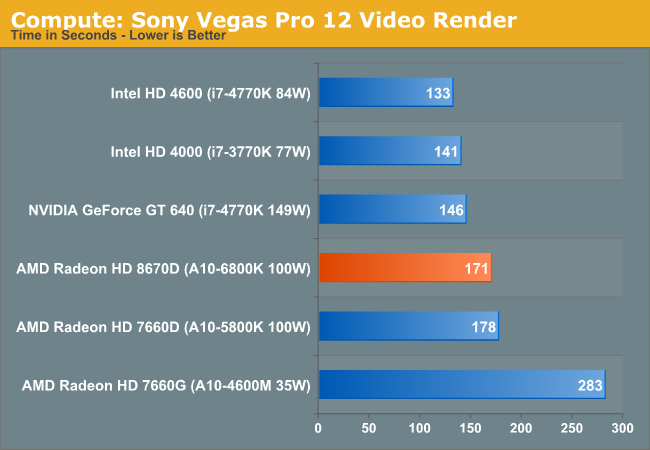
The last compute test goes to Intel, although the two put up a good fight across the entire suite.










102 Comments
View All Comments
taltamir - Thursday, June 6, 2013 - link
"Richland maintains a 17 - 50% GPU performance advantage (~30% on average) over Intel's HD 4600 (Haswell GT2)"And yet consumes more then 2x the power according to your own charts.
And what about the CPU performance? These are desktop parts not laptop parts, their iGPU performance is meaningless
silverblue - Thursday, June 6, 2013 - link
Did you skip just to the conclusion? The reason as to a lack of CPU benchmarks is on the first page.How much power would a 4770K with a GT640 use, incidentally? And at the other end of the scale, what about that 4600M which is rated at 35W yet in a couple of tests beat even the 4770K with its HD 4600? You're asking for results that Anand hasn't managed to grab just yet for reasons as stated on the first page.
There's some strange results in here. In the 3DMark: Fire Strike Extreme test, all three APUs have the same result, but in 3DMark06, the 6800K significantly beats everything else. However, regardless of one or two oddities, the 6800K isn't a real progression over the 5800K... but it was never really made out nor expected to be.
FriendlyUser - Thursday, June 6, 2013 - link
Who cares about power on the desktop? What are you running, a server farm? We're not talking about a 200W part here. The Richland is easy enough to cool as it is. Just because intel based its strategy around a mobile part doesn't mean we have to run behind absolute power/performance ratios. Price/performance makes more sense for the average user.Also, iGPU is very important at that price point. If a $150 CPU saves you a $80 GPU, it's quite attractive. USA readers probably can afford to spend $200 for a dGPU, but struggling european economies and the developing world are a big part of the international market.
ChoadNamath - Thursday, June 6, 2013 - link
"iGPU performance is meaningless" ...except in an APU, where it's pretty much the whole point.shing3232 - Sunday, June 9, 2013 - link
it would not be meaningless for low end desktop. and it is not 2x power consumption in real world. they also have A10-6700 65W TDPwhyso - Thursday, June 6, 2013 - link
Well I think this also shows how close mobile will be. Gt2 at slightly lower speeds than the 4770k (say 1200 mhz 3MB cache for an i5/i3 vs 1300 mhz 8MB cache for 4770k) will be about 10-15% slower. Mobile trinity is going to be approximately equal to haswell mobile gt2 and richland may be slightly ahead but the gap is largely gone.FriendlyUser - Thursday, June 6, 2013 - link
I have always wondered why would anyone paying $330 for a high-end CPU care for a barely adequate iGPU. It's much more reasonable to expect that people looking at the $150 price point will appreciate an iGPU, especially one that is quite decent. The cheapest GT640 I could find was ~$85 (local price), which is no small change. And don't think that the GT640 will get the same scores if paired with the i3...whyso - Thursday, June 6, 2013 - link
yes it will, 640 is way to weak to be bottlenecked by an i3.Spunjji - Friday, June 7, 2013 - link
Indeed. It'll still cost more, though!BSMonitor - Thursday, June 6, 2013 - link
The vast majority of these CPUs do not go to gamers... Their performance is more than acceptable for a large number of use cases if an OEM doesn't want to include a dGPU. However for $330 you get CPU performance that AMD cannot touch at ANY price point or performance/watt..